Solve problems in and around your home.
Start Problem Solver

Is your Phalaenopsis moth orchid wilting and leaves going yellow even though it is well watered? It may have root or crown rot.
Symptoms of root and crown rot include wilted or yellowing leaves. This occurs when the orchid roots are already dying, and the infected roots are not able to absorb water; the plant will look as though it needs watered even though it may be in damp media. Gently and carefully pull the orchid from the pot and check the appearance of the roots. Healthy roots are firm and greenish white, but infected roots will be brown and rotting.

*Alternatively fill a clean bucket or similar container using the SORTED Moss & Mould hose end sprayer.
*Smaller amounts can be measured and diluted, seal the sachet with tape and store for later use.
Let the soil dry slightly, but do not let it dry out completely before watering. Over-watered orchid potting mix and wet foliage promote root and crown rot disease. The top half of the media should feel dry to the touch.
Water your moth orchid once every week, and up to three times a week in hot or dry conditions. Water the plant with room-temperature water in the morning and keep air gently circulating around the orchids.
Check the potting media in the pot. Moth orchids need well-draining potting media that contains coarse materials such as bark, sphagnum moss and/or perlite. Bark can break down and retain too much water. If your orchid has root rot or if the bark in the media is breaking down, re-pot the plant in a new container with new orchid media.
This advice should help you rescue affected orchids and prevent disease spread.